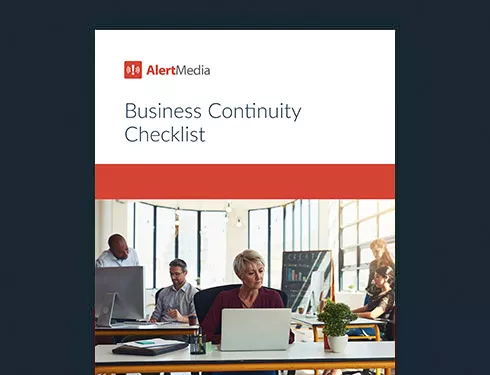
Synthesizing the Benefits of Business Continuity and Disaster Recovery (BCDR)
Disaster strikes when we least expect it, but if you’re prepared in the areas of business continuity and disaster recovery, you can work through and overcome any emergency.

Your business does critical work every day. Whether it’s mass-producing everyday products, providing life-saving medical care, or anything in between—your clients, customers, and personnel expect your organization to maintain a high level of dependability. Even when a disaster like a hurricane strikes, you need to be able to stay on your feet or recover as soon as possible to minimize your company’s downtime.
There is no shortcut to preparedness, but there are processes and frameworks such as business continuity and disaster recovery (BCDR) that can help guide your efforts to resist the effects of hazards and disruptions to your core business activities. This kind of readiness will act as a guiding light in the event of an emergency.
Download Our Business Continuity Checklist
What Is BCDR?
BCDR stands for business continuity and disaster recovery. These two different but similar frameworks are made up of processes, strategies, and solutions that a business can utilize to prevent prolonged disruptions to critical business functions during and after a disaster or significant emergency.
What are the differences between business continuity and disaster recovery?
While business continuity management (the BC in BCDR) is an organization’s ability to maintain core business functions during a disruption or emergency, disaster recovery pertains specifically to that same organization’s power to repair and revamp itself after suffering a disruptive event.
Business continuity
Your business continuity strategy means that no matter what, your critical operations don’t come to a halt, even in the face of disasters like statewide power outages, cyberattacks, or the impacts of the war in Ukraine. Often, the only way to maintain continuity is to have alternatives, such as backup workplaces and tools, prepared ahead of time. Business continuity planning can’t happen after the fact.
Disaster recovery
On the other hand, disaster recovery kicks in once your organization is out of the metaphorical woods of an emergency. It will offer guidelines and recovery solutions for how to get back to normal operations and how to mitigate the longer-term risks of the disaster. With rock-solid threat mitigation plans, you can often avert the need to spend resources on recovery at all.
How do business continuity and disaster recovery work together?
While distinct, these two concepts work together to support your organization’s overall resilience to critical events. Both business continuity and disaster recovery have the goals of minimizing downtime and financial risks from an emergency, and both require similar planning and preparedness efforts.
Business continuity and disaster recovery will include comprehensive documentation and training for both safety leaders and employees. Both elements of BCDR can and should work in tandem to support your business’s crucial operations, and together, they will promote readiness, no matter what threats you face.
BCDR and safety
No matter what, any organization’s first priority is the safety of its employees and clients. No BCDR plan takes precedence over personal health and safety. If there’s no way for employees to perform critical work without being in harm’s way, then to ensure business continuity, you need to develop a system of safe backup worksites and resources that keep everyone away from danger.
Why You Need to Prioritize BCDR
Prioritizing business continuity and disaster recovery (BCDR) is a proven way to protect your business and operations. But it is also a requirement for some organizations. Here are a few reasons why you should consider making BCDR a reality for your business:
- Minimize downtime: Downtime can be incredibly costly for businesses, from lost revenue, lost productivity, and the potential impact on customer trust and loyalty. BCDR planning helps minimize downtime during disruptions.
- Protect key data: BCDR strategies ensure that data is backed up and IT systems can be quickly restored after a disaster, protecting against data loss that could have severe long-term consequences.
- Maintain customer trust and service: Customers expect reliability and continuity of service. By ensuring that operations can continue or be restored quickly after a disruption, businesses maintain customer trust and meet contractual and service-level agreements.
- Regulatory compliance: Many industries have regulations that require businesses to have disaster recovery and business continuity plans in place. For example, the financial services industry is required to comply with the FFIEC business continuity guidelines. Prioritizing BCDR helps ensure compliance with these regulatory requirements, avoiding potential legal and financial penalties.
- Competitive advantage: Businesses with effective BCDR plans can recover from disruptions more quickly than those without, offering a competitive advantage in resilience and reliability.
Watch this step-by-step video to learn how to create and optimize a plan that ensures your operations continue running smoothly—no matter what.
When to implement BCDR
There is a wide range of potential emergencies that might require you to leverage business continuity and disaster recovery strategies. While it’s important to create a more tailored list of what is relevant to your business specifically, here are a few examples:
- Natural disasters: Earthquakes, hurricanes, floods, wildfires, tornadoes, etc.
- Cyberattacks: Ransomware, data breaches, phishing attacks, DDoS attacks, etc.
- IT outages: Server crashes, data protection issues, and network breakdowns
- Facilities emergencies: Power outages, hazmat events, physical security breaches, etc.
- Public health crises: disease outbreaks, air quality alerts, or anything affecting the health of your employees and customers
- Terrorist attacks and civil unrest: Events that could threaten physical assets or employee safety
- Supply chain disruptions: Issues that impact the availability of key goods or services

How to Approach Business Continuity Planning and Disaster Recovery
Any organization, no matter the size or industry, will benefit from strong BCDR planning. Here’s how we think a company new to continuity and recovery should think of it:
The threat assessment
Before you write any of these plans, you first need to get your bearings. You don’t want to waste your time preparing for the (mostly) impossible disasters like a zombie apocalypse or a giant meteor collision. You should prioritize and prepare for the things that are most likely to happen—and those that would have the greatest impact on your continuity and recovery goals. This is best accomplished with a key risk management strategy known as a threat assessment (AKA risk assessment). It looks at the entirety of your business functions and plots specific threats according to their estimated impact. And a ready-made assessment template can get you off to a great start.
Most people know to prepare for natural disaster scenarios, basic cybersecurity, and (now) pandemics, but you might be wondering, “How the heck am I supposed to plan for everything that might happen? What if we run into something we didn’t see coming?” The secret is surprisingly simple: You don’t. On an episode of The Employee Safety Podcast, Larry Pomykalski of SAC Wireless explained that with enough contingency planning and a little creativity, you’ll be ready for anything:
What to include in BC and DR plans
Business continuity and disaster recovery plans vary widely among businesses due to their different needs, but here are some common elements we see in most effective plans.
Elements of a business continuity plan (BCP)
- The type of disruptions the business faces
- The expected duration of the disruptions
- The impacts on the business
- An estimated timeframe before those impacts inhibit business operations
- The recommended changes to process, infrastructure, and resources that could uphold critical functions until these situations are remedied
Elements of a disaster recovery plan (DRP)
- A description of the normal operations
- The types of damage that are likely
- A business impact analysis (BIA)
- Emergency communication plans
- A recovery time objective (RTO)
- A recovery point objective (RPO)
- An emergency action plan including recovery strategies
Business Continuity vs Disaster Recovery Example
To illustrate these concepts, let’s imagine a business, Tracy’s Tractors, that imports, assembles, and sells heavy machinery to clients in their region. They’ve just suffered a fire at their main workshop where most assembly takes place, and restoring it to working condition will take at least a month. Assuming this company had a proper fire evacuation plan and nobody was hurt, how do they maintain business continuity even as they begin the recovery?
Business continuity
To feel confident in your ability to maintain business continuity, you must be able to continue the following even in the face of disruptions:
- Deliver goods or services to your customers
- Receive payment from customers
- Disburse wages to your workers
Tracy and her team know that even a minor slowdown in their production can cause delays in deliveries, which would mean a discontinuity of business. Thankfully, they’ve planned for this. In addition to their workshop, Tracy’s has a large lot full of already-assembled machines that are ready for shipment. They can dip into this backstock to complete current orders while the disaster recovery team works to restore the facilities after the fire damage.
With that backstock, Tracy’s maintains that first part of business continuity and can keep delivering their products. However, the workshop also housed back offices and IT infrastructure for the financial and HR teams which are necessary for parts two and three of the list. They planned for this as well. By issuing laptop computers to their office staff and enacting a policy by which all such employees take their computers home at the end of the day, they’re prepared to continue operations in the midst of disruptions, transitioning to remote work until the new office and workshop are completed.
Finally, they need to coordinate with service providers, supply chain managers, and customers to keep them abreast of what is happening while assuring them that business is continuing.
Disaster recovery
The company has managed to sustain its core business, at least for a while, so they need to recover from the fire as quickly as possible and get back to normal. As a firm with many industrially equipped clients, they’re able to reach out to members of their network including fire damage cleanup and restoration companies that can get their workspace and machinery back to the way it was before.
Tracy’s Tractors works with licensed, proprietary parts from a variety of global manufacturers and need to protect them from theft under the penalty of their contracts. They also need to try and salvage any of the expensive machinery they rely on and prevent any scavengers from making off with it. Assigning security personnel and working with law enforcement will help them avoid further losses.
And finally, they need to ensure that any business data loss from the fire is accounted for. Their offsite, cloud-based storage system captured a snapshot of the day’s work just hours before the fire, ensuring that they only lose a few hours worth of work when that critical data backup is restored to the main system.
How to train in business continuity and disaster recovery
Because of the nature of these responsibilities, their training can take a few different forms. Since business continuity is most concerned with anticipating potential problems, we find that tabletop exercises (TTX) are especially useful. Giving your business continuity team (and related stakeholders) time to walk through a hypothetical situation and brainstorm methods to maintain continuity together will generate novel solutions to problems that your organization hasn’t encountered yet. And when your facilitator adds in some unexpected twists, that adaptability will only strengthen.
You can practice disaster recovery in much the same way with disaster recovery tabletop exercises, but employees will also benefit from more hands-on experience. Exercises such as fire drills and other emergency drills can give your DR team the confidence and familiarity they need to act quickly when executing a BCDR strategy.
Improving your plans
Any plan can be improved over time. Once you have an opportunity to enact your BCDR plans—whether in training or in an actual disaster—make time afterward to perform an after-action review and report. This process will involve all stakeholders and produce an official opinion on the execution of the plan. It will explain what happened, what went well, and what could be improved for next time. Once you have this report, you can revise your original BCDR plans and be even more prepared in the event of a future disaster.
How Does Technology Support BCDR?
Technology plays a crucial role in supporting business continuity solutions and disaster recovery by providing trustworthy solutions and systems to enable your resilience. These solutions can enable data backup and replication, facilitate remote work, ensure seamless two-way communication during disruptions, and more to help minimize downtime. Finding the right technological support for your BCDR efforts can make a significant difference in the speed and effectiveness of your response and recovery.
All Hazards, No Worries
As you’re preparing to start business continuity and disaster recovery planning, it may also help to read up on the all-hazards approach to emergency management. Creating a plan that’s comprehensive and flexible enough to protect your organization from anything the world might throw at it isn’t easy, but it will be well worth it when you and your employees know that you’ve accounted for everything.





